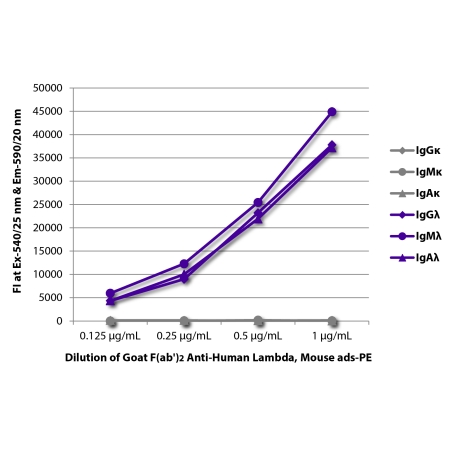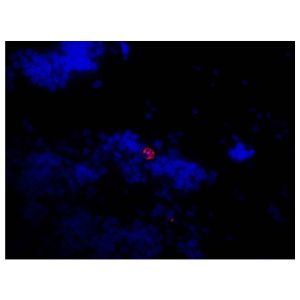Human Lambda, Mouse ads Antibody : PE
Referencia OASB01888
embalaje : 0.25mg
Marca : Aviva Systems Biology
| Datasheets/Manuals | Printable datasheet for Goat Anti-Human Lambda Antibody - PE Conjugated (OASB01888) |
|---|
| Tested Species Reactivity | Human |
|---|---|
| Predicted Species Reactivity | Human |
| Clonality | Polyclonal |
| Isotype | IgG |
| Host | Goat |
| Conjugation | R-PE |
| Application | FLISA, FC |
| Additional Information | Description: Pepsin digest of Goat Anti-Human Lambda, Mouse ads - Pooled antisera from goats hyperimmunized with human lambda light chains; purified by affinity chromatography on human lambda light chains covalently linked to agarose; reacts with human lambda light chains; cross-adsorbed against human kappa light chains / mouse immunoglobulins and pooled sera for minimal reactivity |
| Reconstitution and Storage | Store at 2-8C |
| Immunogen | Human lambda light chains |
| Purification | Affinity chromatography on pooled human Igs with λ light chains covalently linkedto agarose |
| Concentration | 0.25 mg/mL |
| Specificity | Lambda |
| Characterization | To ensure lot- to- lot consistency, each batch of product is tested by ELISA, Fluorescent ELISA, and/or flowcytometry for conformance to characteristics of a standard reference reagent. |
| Warning | Reagents contain sodium azide which is very toxic if ingested or inhaled. Avoid contact with skin, eyes, orclothing. Wear eye or face protection when handling. If skin or eye contact occurs, wash with copiousamounts of water. If ingested or inhaled, contact a physician immediately. Sodium azide yields toxichydrazoic acid under acidic conditions. Dilute azide- containing compounds in running water beforediscarding to avoid accumulation of potentially explosive deposits in lead or copper plumbing. |
| Dilution | Immunofluorescence ELISA: FITC conjugate R-PE conjugate BIOT conjugate BIOT conjugate <= 1 ug/106 cells <= 0.1 ug/106 cells <= 1 ug/106 cells 1:5,000-1:20,000 |
| Application Info | Direct immunofluorescence staining, B cell enumeration, Enzyme-Linked-Immunosorbent-Assay (ELISA), Western blotting, Dot-and slot-immunoblotting, Immunohistochemistry |
| Other Applications Data | Since applications vary, you should determine the optimum workingdilution of the product that is appropriate for your specific need. |
| Storage | - The purified (UNLB) antibody is supplied as 0.5 mg purified immunoglobulin in 1.0 mL of 100 mMborate buffered saline, pH 8.2. No preservatives or amine- containing buffer salts added. Store at 2- 8 C - The fluorescein (FITC) conjugate is supplied as 0.5 mg in 1.0 mL PBS/NaN3. Store at 2- 8 C - The biotin (BIOT) conjugate is supplied as 0.5 mg in 1.0 mL PBS/NaN3. Store at 2- 8 C - The R- phycoerythrin (R- PE) conjugate is supplied as 0.25 mg in 1.0 mL of PBS/NaN3 and a stabilizingagent. Store at 2- 8 C. Do not freeze! - Protect fluorochrome- conjugated forms from light. Reagents are stable for the period shown on thelabel if stored as directed. |
| Cross Absorption | Pooled human myeloma proteins with κ light chains and mouse immunoglobulins |
| Gene Symbol | IGL |
|---|---|
| Gene Full Name | Immunoglobulin lambda-like polypeptide 1 |
| Alias Symbols | IGL@, IGLC6 |
| NCBI Gene Id | 3535 |
| Protein Name | ig lambda-6 chain C region |
| Description of Target | Immunoglobulins recognize foreign antigens and initiate immune responses such as phagocytosis and the complement system. Each immunoglobulin molecule consists of two identical heavy chains and two identical light chains. There are two classes of light chains, kappa and lambda. This region represents the germline organization of the lambda light chain locus. The locus includes V (variable), J (joining), and C (constant) segments. During B cell development, a recombination event at the DNA level joins a single V segment with a J segment; the C segment is later joined by splicing at the RNA level. Recombination of many different V segments with several J segments provides a wide range of antigen recognition. Additional diversity is attained by junctional diversity, resulting from the random additional of nucleotides by terminal deoxynucleotidyltransferase, and by somatic hypermutation, which occurs during B cell maturation in the spleen and lymph nodes. Several V segments and three C segments are known to be incapable of encoding a protein and are considered pseudogenes. The locus also includes several non-immunoglobulin genes, many of which are pseudogenes or are predicted by automated computational analysis or homology to other species. |







